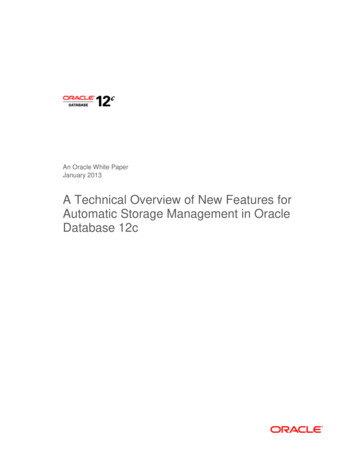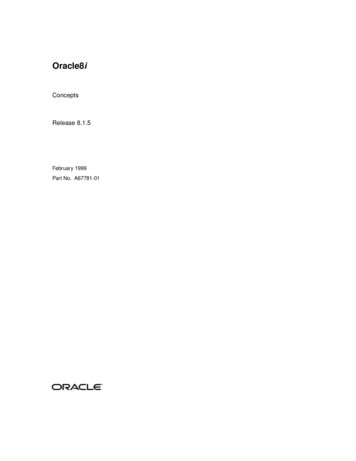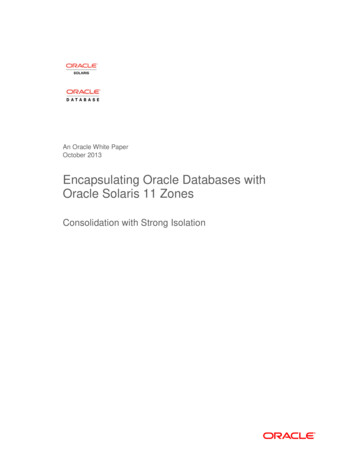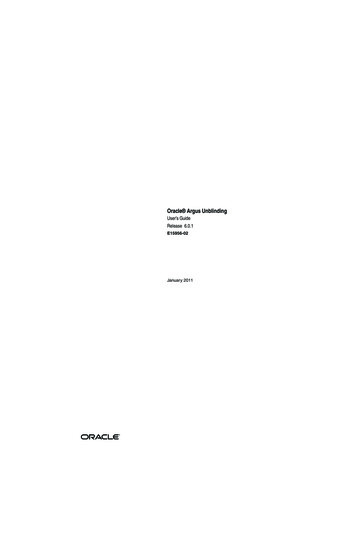
Transcription
An Oracle White PaperJanuary 2013A Technical Overview of New Features forAutomatic Storage Management in OracleDatabase 12c
Oracle Whitepaper - A Technical Overview of New Features for Automatic Storage Management in Oracle Database 12cTABLE OF CONTENTSIntroduction 2ASM Overview 2Total Storage Management for the Oracle Platform 3New ASM Features for Oracle Database 12c 5Automatic Storage Management in the Cloud 5Oracle Flex ASM 5Dedicated ASM Network 6Remote Access 7Other Flex ASM Features 7Deploying Oracle Flex ASM 7Managing Oracle Flex ASM 9ASM Features for Engineered Systems 9Failure Group Repair Time 10ASM Disk Failure Handling Enhancements 10ASM Data Allocation Enhancement 11Extent Reading Selection Enhancement 11Conclusion 12
Oracle Whitepaper - A Technical Overview of New Features for Automatic Storage Management in Oracle Database 12cIntroductionAutomatic Storage Management (ASM) was first released with Oracle Database 10g. For Oracledatabases, ASM provided a significant simplification for file system and volume management. Inaddition to enhancing storage automation, ASM improved file system scalability, performance, anddatabase availability. These benefits hold for both single-instance Oracle databases as well as for OracleReal Application Clusters (Oracle RAC) database environments. Oracle Database 12c introducesseveral new capabilities in ASM. This whitepaper presents these advances and is targeted at a technicalaudience mainly comprising: Database, system and storage administrators Architects Consultants System engineers Technical managersASM OverviewASM is a feature of Oracle database providing an integrated cluster file system and volume manager atno additional cost. ASM lowers the Oracle database storage total cost of ownership and increasesstorage utilization while improving performance and availability as compared with traditional filesystem and volume management solutions. With ASM, less effort is required for managing yourdatabase storage environment.ASM is easier to manage than conventional file systems, it optimizes the performance of your storagehardware, and is tightly integrated with the Oracle Database. Additionally, ASM eliminates the need for3rd-party volume managers and file systems for managing the Oracle database files.Figure 12
Oracle Whitepaper - A Technical Overview of New Features for Automatic Storage Management in Oracle Database 12cASM brings significant key values to Oracle Database platforms. ASM improves manageability bysimplifying storage provisioning, storage array migration, and storage consolidation. ASM providesflexible interfaces for management including the SQL*Plus, Oracle Enterprise Manager, and a UNIXlike command line interface called ASMCMD.In addition to providing ease of management, ASM provides sustained best in class performancebecause of its innovative rebalancing feature. ASM distributes data evenly across all storage resourcesafter storage configuration changes, providing an even distribution of IO and optimal performance.ASM scales to very large databases efficiently without compromising functionality or performance.ASM is built to maximize database availability. ASM provides self-healing automatic mirrorreconstruction and resynchronization, rolling upgrades and patching. ASM also supports dynamic andon-line storage reconfigurations in both single instance and Oracle RAC database configurations. ASMcustomers realize significant cost savings and achieve lower total cost of ownership because of featuressuch as just-in-time provisioning, and clustered pool of storage making it ideal for databaseconsolidation. ASM provides all of this without additional license or licensing fees.In summation, ASM is a file system and volume manager optimized for Oracle database filesproviding: Simplified and automated storage management Increased storage utilization, uptime, and agility Delivering predictable performance and availability service levelsTotal Storage Management for the Oracle PlatformWith Oracle Database Release 11.2, Oracle added ASM Cluster File System (ACFS) to complimentAutomatic Storage Management. ACFS provides the same level of storage management provided byASM. ACFS simplifies and automates storage management functions, increases storage utilization,uptime and agility to deliver predictable performance and availability for file data stored outside anOracle Database. ACFS includes: Automatic Storage Management Dynamic Volume Manager as a volume managerfor Automatic Storage Management Cluster File System and 3rd party file systems. Automatic Storage Management Cluster File System provides advanced data services and securityfeatures for managing general purpose files. ASM, ACFS, and Oracle Clusterware are bundled as a complete package and is called Oracle GridInfrastructure.3
Oracle Whitepaper - A Technical Overview of New Features for Automatic Storage Management in Oracle Database 12cFigure 2ASM Cluster File System, Automatic Storage Management and Oracle Clusterware are bundled as asingle offering as Oracle Grid Infrastructure. Oracle Grid Infrastructure provides an integrated foundationfor database and general purpose files as well as an infrastructure for clustered environments. TheOracle Grid Infrastructure streamlines management of volumes, file systems and clusterconfigurations, therefore eliminating the need for multiple 3rd party software layers that would addcomplexity and cost.“With the ASM feature, DBAs won’t have to worry about optimizing disk I/O.ASM eliminates hot spots by evenly distributing data providing the optimalbandwidth that an end user or an application needs” Arvind Gidwani,Senior Manager IT, Qualcomm“ASM solves the majority of the performance and manageability issues ofusing low-cost storage to run Oracle on Linux and allows you to build verylarge, high- performance systems” Grant McAlisterPrincipal Database Engineer Amazon.com4
Oracle Whitepaper - A Technical Overview of New Features for Automatic Storage Management in Oracle Database 12cNew ASM Features for Oracle Database 12cAutomatic Storage Management in the CloudWhen ASM was introduced in Oracle 10g, it was designed to address one goal really well; to improvethe manageability of storage for Oracle databases. The next major evolution for ASM was in OracleRelease 11.2 with the introduction of ASM Cluster File System (ACFS). ACFS provided completemanageability for all customer data. In a continuing fashion, ASM in Oracle Database 12c addressesstorage management needs for cloud computing in the enterprise. Cloud computing in the enterprisemeans applications and their supporting infrastructure are malleable within and across clusters andservers. New features in ASM for Oracle Database 12c enable storage management to seamlessly adaptto changing requirements and configurations. Furthermore, this evolution brings several new featuresgreatly enhancing management for Oracle’s engineered systems, such as Exadata and the OracleDatabase Appliance.Oracle Flex ASMThe most significant enhancement for ASM in Oracle Database 12c is a set of features collectivelycalled Oracle Flex ASM. Oracle Flex ASM provides for critical capabilities required for cloudcomputing in enterprise environments. These environments typically deploy database clusters ofvarying sizes that not only have stringent performance and reliability requirements, but theseenvironments must be able to rapidly adapt to changing workloads with minimal managementoverhead.Oracle Flex ASM fundamentally changes the ASM cluster architecture. Before the introduction ofOracle Flex ASM in Oracle Database 12c, an ASM instance ran on every server in a cluster. TheseASM instances communicated with other ASM instances on other servers in the cluster and collectivelythey presented shared Disk Groups to the database clients running in the cluster. This collection ofASM servers formed an ASM cluster. If an ASM instance were to fail, then all the database instancesrunning on the same server as the failing ASM instance failed as well. The gray boxes in figure 3represent ASM instances in a pre-12c environment.Figure 3Oracle Flex ASM in Oracle Database 12c changes the architecture regarding the ASM clusterorganization. In Oracle Database release 12c, only a smaller number of ASM instances need run on asubset of servers in a cluster. The number of ASM instances running is called the ASM cardinality. If aserver fails that is running an ASM instance, Oracle Clusterware starts a replacement ASM instance ona different server to maintain the ASM cardinality. If an ASM instance fails for whatever reason, then5
Oracle Whitepaper - A Technical Overview of New Features for Automatic Storage Management in Oracle Database 12cactive Oracle 12c database instances that were relying on that ASM instance will reconnect to anothersurviving ASM instance on a different server. Furthermore, database instances are connection loadbalanced across the set of available ASM instances. The default ASM cardinality is 3, but that can bechanged with a Clusterware command. These features are collectively called Oracle Flex ASM.Figure 4: Flex ASMFigure 4a: ASM Instance failoverFigure 4 illustrates the ASM architecture with Oracle Flex ASM. There are a reduced number of ASMinstances on selected servers in the cluster and Oracle Database 12c clients can connect across thenetwork to ASM instances on different servers. Furthermore, Oracle Database 12c clients can failoverto a surviving server with an ASM instance if a server with an ASM instance fails, all without disruptionto the database client.Dedicated ASM NetworkOracle Database 12c provides for the ability to dedicate a private network for ASM network traffic.The traffic on the ASM network is usually not overly significant and mostly metadata such as aparticular file’s extent map. If desired, the Oracle Clusterware private network can be shared with ASMand a dedicated ASM network is not required. The Oracle installer presents the DBA with the choiceas to whether a dedicated network is required for ASM.6
Oracle Whitepaper - A Technical Overview of New Features for Automatic Storage Management in Oracle Database 12cFigure 5Remote AccessBefore Oracle Database 12c, database clients use operating system authentication to log into an ASMinstance. Historically, this approach worked well because the database instances and the ASM instanceran on the same server. With Oracle Database 12c, the database instances and ASM instances can nowbe on different servers, so ASM instances require a password file that is used to authenticate a databaseinstance connecting to an ASM instance within the cluster. For most configurations a default ASMpassword file is created during installation and it is stored in an ASM Disk Group.The ability of storing password files in a Disk Group is extended to Oracle Databases 12c clients.Having a common global password file in a cluster addresses common issues related to synchronizingmultiple password files that had to be used previously.Other Flex ASM FeaturesOther important features of Oracle Flex ASM include; The maximum number of ASM Disk Group is increased from 63 to 511. Oracle Flex ASM supports larger LUN sizes for Oracle Database 12c clients (increased to 32 PB). There is now a command for renaming an ASM Disk in a Disk Group. All the instances in an ASM cluster ensure they are running the same code release by validating thepatch level across the cluster.Deploying Oracle Flex ASMFor environments where ASM in Oracle Database 12c is deployed with databases running previousreleases of Oracle, some new ASM features are not available to the older database clients. The criticalcapabilities unavailable are associated with pre-12c database clients not being able to access Oracle FlexASM instances’ running on remote servers from the server the database instance is running on. Thereare two models for how to deploy Flex ASM in such environments; In a Greenfield Deployment, FlexASM and Oracle 12c databases are created in separate clusters. Over time applications and data are7
Oracle Whitepaper - A Technical Overview of New Features for Automatic Storage Management in Oracle Database 12crelocated to the Oracle Flex ASM environment. This model offers the most separation betweenprevious database releases and Oracle Database 12c. See figure 6.Figure 6The second approach provides for a mixed environment of previous database releases and OracleDatabase 12c clients in the same cluster. In this particular model, both Oracle release 12c and previousdatabases releases are operated in a cluster with an Oracle 12c ASM instance running on every server inthe cluster. As before, ASM Disk Group compatibility attribute is use for managing the compatibilitybetween database instances.There are two ways to achieve this mixed model of operation. The first is to install the cluster instandard mode which assigns an ASM instance to every server. However, in standard mode, if an ASMinstance fails, then Oracle 12c database instances using that ASM instance fail as well.Another way to achieve the objective of an ASM instance on every server is to install Oracle Flex ASMand set the ASM cardinality to “all” which insures that there is an ASM instance on every server in acluster. The advantage of this approach is that if an Oracle 12c database instance loses connectivitywith an ASM instance, then the database connection will failover to another ASM instance on adifferent server. See figure 7.8
Oracle Whitepaper - A Technical Overview of New Features for Automatic Storage Management in Oracle Database 12cFigure 7Managing Oracle Flex ASMOracle Flex ASM requires only minimal monitoring and ongoing management after initialconfiguration. The primary objective for administrators is that the ASM instances are up and running.This can be done using the Clusterware Oracle Clusterware srvctl command.In Oracle Database 12c, there are no new instance parameters that are specific to Oracle Flex ASM. Inaddition, the default parameter settings have been adjusted to suit the Oracle Flex ASM architecture,making them sufficient to effectively support most situations.ASM Features for Engineered SystemsThere are several features in ASM for Oracle Database 12c facilitating the unique characteristics ofOracle’s engineered systems, including Exadata and Oracle Database Appliance. While these featuresadd value to Oracle’s engineered systems, most of these features also provide similar capability fordeployments of non-engineered systems. These features include;9
Oracle Whitepaper - A Technical Overview of New Features for Automatic Storage Management in Oracle Database 12cFailure Group Repair TimeWhen an individual ASM Disk fails because of hardware fault, the failure is often terminal and the diskmust be replaced. However, when all the ASM Disks in an ASM Failure Group fail simultaneously, it isunlikely that all the disks individually failed at the same time. Typically, it is more likely that sometransient issue caused the failure associated with the ASM Failure Group. For example, all the disks inan ASM Failure Group in an Exadata environment would become unavailable when there is a transientfailure of an Exadata storage cell. Because Failure Group outages are more likely to be transient innature, and recovering redundancy through an ASM rebalance is far more expensive than replacing asingle disk, it makes sense in these environments for the loss of a Failure Groups to have a larger repairtime than that of an individual disk. A larger repair time value ensures that all the disks are not droppedautomatically in the event of a short term and recoverable Failure Group outage. Consequently, ASMin Oracle Database 12c provides for a new Disk Group attribute called “failgroup repair time” thatdefaults to 24 hours.ASM Disk Failure Handling EnhancementsOracle 12c introduces a new feature that helps with the management associated with mirrorsynchronization in normal and high redundancy Disk Groups. This feature provides administratorswith the ability to control the amount of resources dedicated to mirror re-synchronization. This issimilar to the capability in previous ASM releases allowing administrators to control the use ofresources dedicated to a Disk Group rebalance operations.A related feature of resync in Oracle Database 12c ASM is that if a resync operation is interrupted andlater restarted, the previously completed phases of the resync are skipped and processing isrecommence at the beginning of the first remaining incomplete phase of the resync operation.If an ASM Disk goes offline and cannot be repaired, administrators have to replace the disk. In priorversions of ASM, administrators had to drop the faulty disk and then add a new one back into the DiskGroup. In the process, the entire Disk Group is rebalanced. This can be quite expensive with respectto moving data and time consuming. Oracle Database 12c ASM allows administrators to simply replacean offline disk using one fast and efficient operation. Using this feature, the replacement disk ispopulated with mirror copies of the ASM extents from other disks, and there is no need for anyadditional reorganization or rebalancing across the rest of the unaffected Disk Group.In some situations, ASM rebalance operations are required to restore data redundancy within DiskGroups using normal or high ASM redundancy. For example, if a disk fails and no replacement disk isavailable, a rebalance is required to redistribute the data across the remaining disks in the Disk Groupand restore redundancy. With Oracle Database 12c ASM, priority ordered rebalance is provided. Thisfeature prioritizes on quickly restoring the redundancy of critical files first, such as control files andonline redoes log files, to ensure that they are first protected against a secondary failure.Since the first release of ASM, when data block is read, a series of checks are performed on datavalidating the block’s logical consistency. If corruption is detected, the database automatically recoversby reading the mirror copy when normal and high redundancy Disk Groups are used. Extending thistype of protection against hidden corruption for non-accessed data is a new feature for OracleDatabase 12c. Under administrative control, ASM can proactively check for data corruption, evenwithout any database client accessing the data. The value of proactive scrubbing is that without it, thereis the possibility of multiple corruptions affecting all the copies of data that are infrequently accessed.Proactive scrubbing checks for, and where possible, repairs corruptions detected. Furthermore, thisdata checking can be triggered during rebalance operations or under execution of a scrubbing10
Oracle Whitepaper - A Technical Overview of New Features for Automatic Storage Management in Oracle Database 12ccommand. On-demand scrubbing can be performed on a Disk Group, on individual files or individualdisks.ASM Data Allocation EnhancementFor normal and high redundancy ASM Disk Groups, the algorithm determining the placement ofsecondary extents uses an adjacency measure to determine the placement of mirror copies of data. Inprior versions of ASM, the same algorithm and adjacency measure was used for all Disk Groups.Oracle Database 12c ASM provides administrators with the option to specify the content typeassociated with each ASM Disk Group. Three possible settings are allowed: data, recovery and system.Each content type setting modifies the adjacency measure used by the secondary extent placementalgorithm.The benefit is that the contents of Disk Groups with different content type settings are distributedacross the available disks differently. This decreases the likelihood that a double-failure will result indata loss across normal redundancy Disk Groups with different content type settings. Likewise, atriple-failure is less likely to result in data loss for high redundancy disk groups with different contenttype settings.Figure 8Extent Reading Selection EnhancementIn previous releases of ASM, the default behavior for ASM is to always read the primary copy of amirrored extent unless a failure condition required otherwise. Alternatively, administrators couldconfigure preferred read failure groups for extended cluster environments. For each I/O request presentedto an ASM Disk Group with normal or high redundancy, there are one or more disks containing thedata. The Even Read feature of Oracle Database 12c ASM, evenly distributes the selection of whichcopy of a block is read. With Even Read enabled, each read request is sent to the least loaded of theavailable disks.Even Read is enabled by default on for Oracle Database 12c. Because Even Read is transparent toapplications, users on I/O bound systems should notice a performance improvement after upgradingto version Oracle Database 12c. Note that Even Read does not replace the functionality provided bypreferred read failure groups.In an Exadata environment with Oracle Database 12c ASM, most extent relocations performed by arebalance operation can be offloaded to Exadata Storage cell. With this capability, a single offloadrequest can replace multiple read and write I/O requests. Offloading relocations avoids sending data tothe ASM host, consequently improving rebalance performance.11
Oracle Whitepaper - A Technical Overview of New Features for Automatic Storage Management in Oracle Database 12cConclusionASM in Oracle Database 12c continues an evolution of superior storage management for the Oracledatabase that began with Oracle 10g. In Oracle 10g ASM was designed to address one goal really well;to improve the automation and manageability of storage for Oracle databases. The next phase forASM’s evolution was in Oracle Release 11.2 with the introduction of ACFS providing completemanageability for all customer data. ASM in Oracle 12c continues this tradition by addressing storagemanagement requirements for cloud computing in the enterprise. New features in ASM for Oracle 12cenable storage management to seamlessly adapt to changing requirements and configurations. Part andparcel of this phase brings several new features enhancing management for Oracle’s engineeredsystems, such as Exadata and the Oracle Database Appliance.12
Oracle Whitepaper - A Technical Overview ofCopyright 2013, Oracle and/or its affiliates. All rights reserved.New Features for Automatic StorageManagement in Oracle Database 12cThis document is provided for information purposes only, and the contents hereof are subject to change without notice. ThisJanuary 2013document is not warranted to be error-free, nor subject to any other warranties or conditions, whether expressed orally or implied inAuthor: Jim Williamslaw, including implied warranties and conditions of merchantability or fitness for a particular purpose. We specifically disclaim anyContributing Authors:liability with respect to this document, and no contractual obligations are formed either directly or indirectly by this document. ThisOracle CorporationWorld Headquarters500 Oracle ParkwayRedwood Shores, CA 94065U.S.A.document may not be reproduced or transmitted in any form or by any means, electronic or mechanical, for any purpose, without ourprior written permission.Oracle and Java are registered trademarks of Oracle and/or its affiliates. Other names may be trademarks of their respective owners.Intel and Intel Xeon are trademarks or registered trademarks of Intel Corporation. All SPARC trademarks are used under license andWorldwide Inquiries:are trademarks or registered trademarks of SPARC International, Inc. AMD, Opteron, the AMD logo, and the AMD Opteron logo arePhone: 1.650.506.7000trademarks or registered trademarks of Advanced Micro Devices. UNIX is a registered trademark of The Open Group. 0113Fax: 1.650.506.7200oracle.com
Database, system and storage administrators . New ASM Features for Oracle Database 12c Automatic Storage Management in the Cloud When ASM was introduced in Oracle 10g, it was designed to address one goal really well; to improve the manageability of storage for Oracle databases. The next major evolution for ASM was in Oracle











